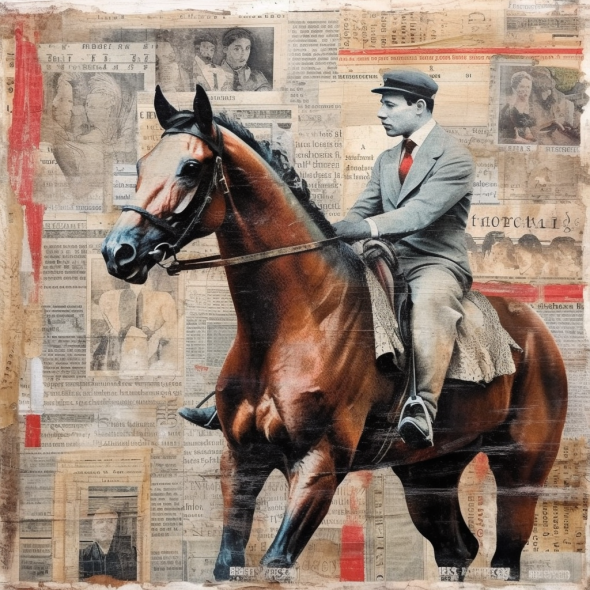Press betting is very popular with punters with daily predictions on almost all races, but is it worth following?
Can you be profitable in the long term by following these predictions or are they just there to force you to play?
Table of Contents
- Press betting regularly features favourites
- Low Player Return Rate (PRR) in horse betting
- Are the tipsters in the horse-racing press profitable?
- Conclusion
Press betting regularly features favourites
The different equestrian press (internet, newspapers, radio, television) give the majority of the favourites at the top of their predictions.
There are several reasons for this:
- By definition, the favourite with low odds has a greater theoretical chance of winning than another horse with higher odds, so it is not illogical to see the favourites leading the predictions.
- By definition, the favourite with low odds has a greater theoretical chance of winning than another horse with higher odds, so it is not illogical to see the favourites leading the predictions.
- Forecasters rarely study the race in any detail, given the number of races they have to forecast each day, which is why they put the favourites at the top of their opinions.

The real unanswered question is whether it is the favourites who are given the status of favourites by the horse-racing press or whether it is the horse-racing press that makes the targeted horses favourites through their media coverage?
Would the odds be the same if the favourite was not given by the horse press?
The more followers the press has, the more likely it is that the odds of the first horse in the prediction will fall, due to the mutualized betting.
For information and according to our studies the favourite wins in only 50% of the cases.
The average odds of all the favourites is 2.30 but the average odds of the favourites who finish first is 1.90, so you can't be a long-term winner with average odds of 1.90 and a 50% win rate.
Low Player Return Rate (PRR) in horse betting
The Player Return Rate, more commonly known as PRR, is the proportion of bets redistributed to winning players. This fluctuates according to the period of the year, but the State requires an average RPR that cannot exceed 85% for single games over a period of two consecutive quarters.
The PRR is low in all horse betting (according to the article published on 15 February). Thanks to PMU data, for single bets the average TRJ is 85%, i.e. out of €100 of bets, only €85 is paid back to the winning bettors. The remaining €15 is partly the bookmaker's margin, partly taxes imposed by the State, partly operating costs and partly paid back to the horse industry.
Regarding other types of bets, we note that :
- For the coupled and 2 on 4 game, the average FIT is 74%.
- For the Trio, the average FIT is 63% and for PMU's flagship game, the average FIT for Quinté+ is only 65%.
These constraints of government taxes and an average FIT of 85% for single game do not apply to bookmakers who are not regulated by theNational Players' Authority (ANJ), i.e. by foreign bookmakers. This is the same case as for sports betting, where unregulated bookmakers offer FITs of around 94 or 95% (such as Pinnacle, Betfair, etc.).
You will notice that the more complex the bet (several horses to find), the lower the FIT. Therefore, the simpler the bet, the better the return.
Are the tipsters in the horse-racing press profitable?
If you read or listen to the horse-racing press, they have at least one, if not several, prognosticators in profit, but how do they do it?
Unfortunately this information is in 99% of the cases false and very false.
It is important to know that most of the horse racing press give their predictions in 8 horses, so there is a good chance of having the winner, or a pair or a trio, or even the quinté in 8 horses. But if all the predictions were made with 8 horses, it would cost the punter a fortune. A pair played with 8 horses costs 28 times more than a pair played with only 2 horses.
Similarly, a quinté with 8 horses costs 56 times more than a quinté with only 5 horses.
The press praises his performance of the previous day with his 8-horse prediction, but in the long run, the record is a loser. Moreover, when a press praises the results of one of its prognosticators, the bet put forward is never the same, sometimes it is a big report in the single game, sometimes in the Tiercé, sometimes in the Quinté, ...
It should be noted, however, that the Turfomania fournit des statistiques et des bilans sur les bilans de ses équipes. Libre à vous de vérifier les performances affichées quitte à faire un suivi à blanc dans un premier temps !
A press with several tipsters in its ranks will regularly have nice reports on one type of bet, but not over the long term. If the tipster were profitable in the long run, he would keep his tips to himself, to avoid drops in the odds, but this is obviously not the case.
If we are talking about a balance sheet, do you know of many tipsters in the horse-racing press with a long-term balance sheet with the same type of game and showing the stakes and winnings? The answer is no because with 8 horses the cost is exorbitant and playing favourites you need a huge success rate taking into account the low FIT.
Conclusion
The predictions of the horse-racing press should be followed with extreme caution because they are often favourites, with consequently low ratios, and to be a winner in the long term, you need a very high success rate, which is not the case for almost all the predictors.
The predictions of the horse-racing press should rather serve as an aid to decision making and the bettor should not play all the races, but choose his races according to the number of starters, the discipline with which he is most at ease, ...
Refraining from betting is sometimes the best bet when the choice is difficult.

Add a comment